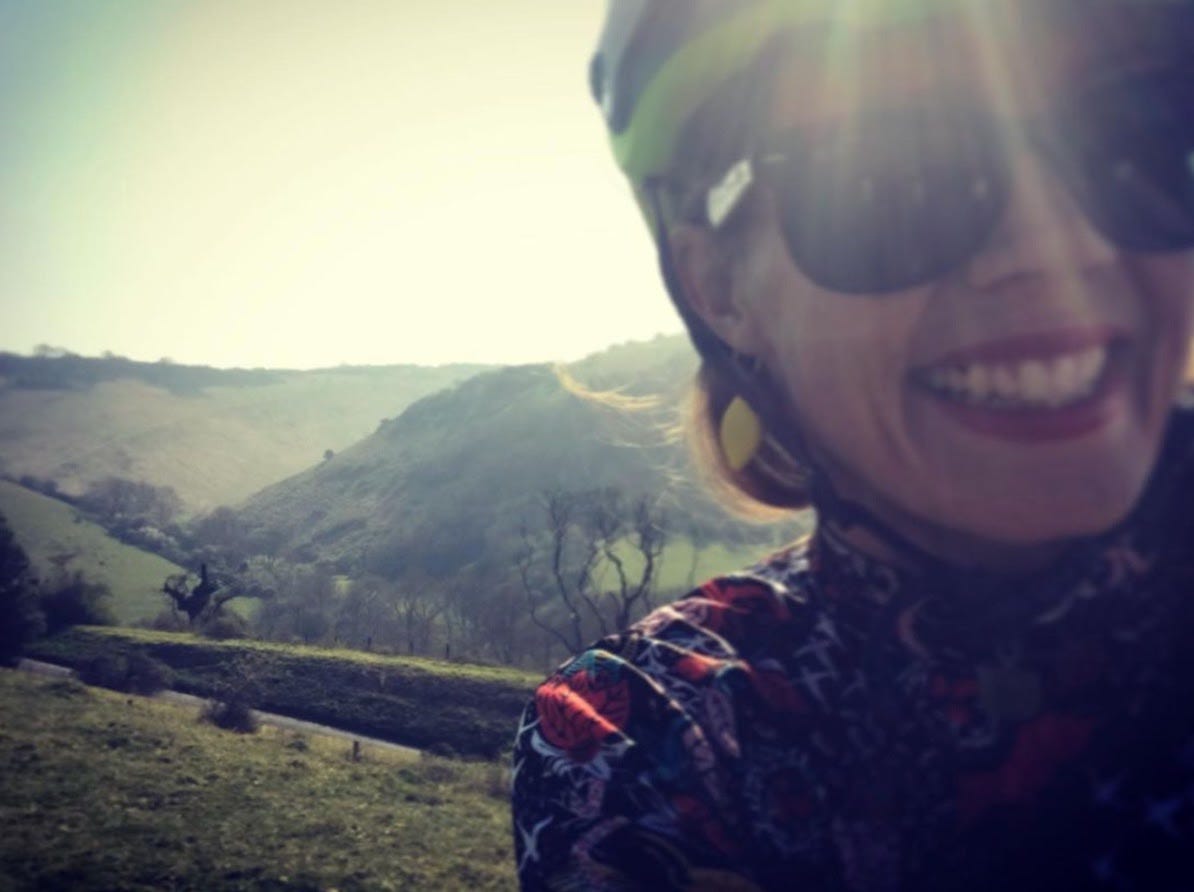Conversation is the solution to anxiety
To overcome climate despair, we have to allow ourselves to feel it
Simple climate action // I S S U E # 2 2 // C L I M A T E D E S P A I R
Our challenge this month isn’t a task. It’s a conversation.
Climate anxiety keeps many up at night, even driving some to despair at times. And just as often it leaves us unable to act. That paradox was the genesis for Hothouse’s theme of climate anxiety over the past month.
As someone who writes about climate and energy for a living, I feel this all the time. It’s easy to numb up amid all the dire statistics and predictions. But climate anxiety, at its core, is a form of denial — a reality we don’t want to face but can’t ignore. It’s not just the knowledge itself that causes the anxiety. It’s the running away from it.
So now I try to actually feel the unease about what’s coming, rather than shunting it aside. That allows me to move beyond it. I find I have more energy and joy in my life when I'm not busy denying a piece of it. Philosopher Joanna Macy calls this “active hope.”
We’re not going to recommend “doing something” this week. Instead, we’ll ask you to take some time to just experience what you’re feeling, and talk about it with someone you know or trust. Have a conversation about the future with a friend or family: What scares you about climate change? What better world could you imagine? As the psychologists we interviewed this month told us, we can’t sustain action until we’re honest about how we’re really feeling. These conversations help us discover the solutions in our own lives.
This week, we talked to a range of people — a former Army engineer and adventurer, a teacher, and Jemima’s mum — about how they deal with their climate anxiety. It gave us a bit of insight into how they face climate anxiety in their life, and might give you some inspiration for yours.
Mike Coren
Finding a way forward with friends and family
Back home in England, my Mum has always had beautiful gardens. We built obstacle courses, made mud pies and played in the beautiful den she made for us under a cherry tree. They provided much of our fresh fruit and veg, our place to play and hide and even camp some nights, surrounded by abundant color and life. The garden was the best room in our house. My Mum even named the trees.
Her garden is smaller these days but no less wonderful. It’s also a refuge where she pours all her care, attention and stress. “I have nightmares about drowning polar bears,” she told me. “I feel this is the end of the world - the whole planet is being killed off. I’ve noted over the past few years that summers are shorter and autumn comes earlier. It rains more heavily, and there’s more localized flooding. There are fewer songbirds, and hedgehogs don’t come anymore.”
She found the wildfires in Australia particularly harrowing to watch because of the impact on wildlife. It’s hard, she says, to switch off her concerns at night. “My brain just doesn’t stop. Climate change is like a black cloud hanging over my head.” Mum explained that these concerns aren’t easy to talk about during her long phone calls with friends. Climate change only ever seems to be something spoken about in passing, perhaps because it’s just too overwhelming.
Volunteering isn’t an option for her because she finds it hard to travel, so her outlet is the garden. She’s caring for her small patch of the Earth, for the birds and toads and insects that thrive in her little patch of heaven. Despite a lifetime as an art teacher, she describes her garden as more important than art — a marriage of color and design with practicality and nature. “It’s instinctive. I feel plugged in and I learn all the time. It’s nurturing and caring, and takes so much of my energy.”
Getting into local politics
A physics teacher and former British Army engineer with infectious enthusiasm, Dani French is in her third year of fulfilling 42 challenges before she turns 42. These have included a week of cold showers, rowing 100 miles along the south coast of England, and not complaining for one month. Environmental responsibility is one of the challenges she has set for herself.
“I think about climate change every day,” she says. “I’m a parent and guardian of the children in my care, and believe we should be handing over the planet in a better condition than we found it. So recycling, cutting out food waste and minimizing buying are things I take really seriously. It’s just part of my repertoire, whether I’m shopping or traveling or cooking - I don’t think about tasks in isolation.”
In 2020, Dani teamed up with other people in the community. She joined the Green United project in the nearby town of Lewes, Sussex, a student-led project to reduce the carbon footprint of schools from catering and transport to the curriculum. It’s due to launch later this month.
And while doing her 20-mile a day challenge to cycle to and from work over the challenging Sussex Downs, Dani grew increasingly concerned about a dangerous road crossing near her home village. The crossing is also part of the ancient and much-loved South Downs Way, a 100-mile hiking trail across the hills of southern England. “Our village is between two busy roads and this is really a very dangerous crossing,” she say. “So I set up a petition to make the crossing safer, but also because it would allow local people to feel safe enough to walk more, rather than having to drive. I started going to every council meeting to push this issue and eventually when one councilor left, they suggested I applied. So I did. It is a council with very little diversity, so I’m very pleased to be able to push green issues up the agenda.”
Dani says she often talks to friends about the work she’s doing but tries to be sensitive not to make people feel pressured. “I’m not blaming anyone. I just know that positivity ripples out, and that it's best just to show people what you’re doing yourself. I’m also really privileged that because I’m a teacher, I get to spend so much time with kids and change their thinking. I try not to miss an opportunity to make people think about climate justice. Every single thing in our lives will be affected by climate change. We will mourn for the fact that our children won’t have the same world that we had.”
Yoga for anxiety
Clare Ryan has been teaching yoga, and educating yoga teachers, for 15 years. A Brit in New York City, Clare’s approach to yoga is supportive and reassuring, but very practical. Relaxation and restorative yoga is a key part of her teaching, but she says it is no replacement for taking practical environmental action. “It’s not enough to be passive, and just to hope for the best,” she says. “We all need to take practical, collective action. For me, that means that all the practical decisions I make about food, travel, and shopping throughout the day are underpinned by an awareness of the impact I am having.”
Some simple exercises can help us cope with moments of overwhelming stress or anxiety, she says. Anxiety comes from worrying about something in the future that hasn’t happened yet, or reliving a stressful moment from the past. Mindfulness techniques allow us to consciously pay attention to the present moment without judgment. Once we aren’t overwhelmed by the past or future, we can create the life, and world, we’d like to see.
Allow yourself to pause
You can do this sitting, standing or lying down. Place one hand on your tummy and one on your heart, and close your eyes.
It is helpful to ground yourself by feeling your connection to the surface you are on. Feel your points of contact with the ground and use that to orient yourself. Sensing your physical environment brings you out of your head and into your body, and is immediately calming.
Be here now. Listen to what’s happening around you, the smells around you. Recognize what is present and real right now.
Bring attention to your breathing
Calm, steady breathing regulates our nervous system and pulls us out of the fight, flight or freeze nervous response.
Feel how your breath moves your body as you inhale and exhale. You can concentrate on the feeling of the air moving in and out of your lungs, or air passing through your nose. When we are anxious, our breathing tends to become shallow, so try to breathe deeply into your belly as if your whole body is breathing. Stay with it for a period of time and you will find your breathing becomes calmer.
Breathe in and out for an equal length of time, say for a slow count up to four or five. This should continue to calm your nervous system and give your brain something simple to concentrate on that is happening in the present moment.
Make time to calm your system
Lie on the floor with your back comfortably flat, and your legs elevated on a sofa or chair. You can also lie with your legs up the wall.
Make sure your back is comfortable, and that you are warm and with a cushion under your head. Cover yourself with a blanket and use an eye mask if you wish.
Allow yourself to rest there for 10 minutes while concentrating on your breath. This position signals to your body that you are allowing it to calm down, and dedicating time to calming your nervous system.
Jemima Kiss
Hothouse is a weekly climate action newsletter written and edited by Jemima Kiss, Mike Coren, and Jim Giles. We rely on readers to support us, and everything we publish is free to read.










